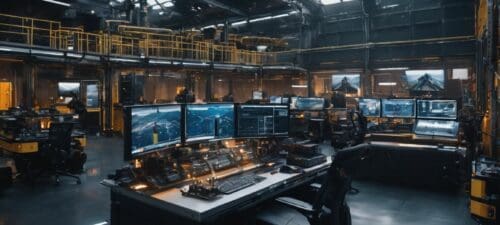BioShock Infinite: A Sky-High Utopian Nightmare

Updated On: November 19, 2025 by 
Have you ever found yourself musing over the tantalising idea of an impeccable city nestled amongst the clouds, only to peel back its layers and uncover the shrouded enigma within? We’ve navigated the lofty skyways of Columbia in BioShock Infinite, peering into a realm where idealism grapples with dystopian shadows.
Our excursion through this riveting title has not just treated us to a visual feast and heart-pounding escapades but also exposed us to the disconcerting realities lurking beneath a community poised on a delicate brink.
Join us as we embark on an odyssey that’s equally resplendent and thought-provoking.
Setting the Stage: The City in the Sky
The setting of BioShock Infinite takes place in a mysterious city suspended high above the clouds, presenting a utopian society ruled by a charismatic leader and fuelled by propaganda.
The game’s world is visually stunning, with its high-flying city and pseudo-Christian society depicted through stunning graphics and music.
A utopian society
We soar into BioShock Infinite’s city of Columbia, a highflying utopia that floats among the clouds, embodying a dream of perfection. Constructed to showcase American excellence and religious purity, this mysterious city was once tethered to U.S. ideals but has since declared independence.
The initial calm masks deeper turmoil; beneath its gleaming façade lies an unsettling truth waiting to unravel.
Our journey through Columbia dazzles us with its grandeur—a testament to unchecked ambition. Lush parks and sunlit streets paint a picture of bliss, while propaganda echoes from every corner enforcing the illusion of a flawless community.
Yet as we explore further, hints of underlying darkness pierce through the Pseudo-Christian society‘s polished exterior, suggesting that this militant utopia may not be as idyllic as it seems.
Ruled by a charismatic leader
With the idyllic facade of a utopian society, Columbia was ruled by a charismatic leader whose influence permeated every aspect of life in the sky-high city. Comstock, the enigmatic figure at the helm, used his powerful persona to shape the citizens’ beliefs and fuel their loyalty through propaganda and carefully orchestrated public appearances.
His persuasive rhetoric and imposing presence stood as a testament to his hold over the people, compelling them to adhere to his vision for Columbia while concealing dark truths beneath its gleaming exterior.
The magnetic allure of Comstock’s leadership added an unsettling layer to the game’s portrayal of unchecked power and its impact on those under its sway.
Fuelled by propaganda
Ruled by a charismatic leader, the city of Columbia in BioShock Infinite is fuelled by propaganda that shapes and controls the thoughts and behaviours of its citizens. The game’s narrative expertly exposes how propaganda can be used to manipulate people into blindly following ideologies, further emphasising the oppressive nature of the society.
Players witness firsthand the impact of this propaganda on the inhabitants, underscoring the unsettling power dynamics at play within this seemingly idyllic world.
Delving into the Nightmares
Uncovering the underlying oppressive ideologies and their impact on the citizens of Columbia, as well as exploring the unsettling music and visuals that add to the nightmarish atmosphere.
The underlying oppressive ideologies
The game delves into the underlying oppressive ideologies present in Columbia, mirroring real-world phenomena. The city’s militant society is fuelled by propaganda and ruled by a charismatic leader, reflecting historical instances of unchecked power.
This oppression has a profound impact on the citizens, as they are subjected to strict rules and societal expectations that limit their freedom and individuality.
Moreover, the unsettling music and visuals in BioShock Infinite serve to emphasise the oppressive nature of the society. Through uncanny tunes and striking imagery, players are immersed in an environment reflective of social control and manipulation, creating a chilling atmosphere that adds depth to the game’s exploration of these themes.
The impact on the citizens
The citizens of Columbia are heavily influenced by the city’s oppressive ideologies, which shape their lives in profound ways. Through propaganda and manipulation, they are subjected to a society that enforces rigid social hierarchies and strict conformity.
The citizens experience a loss of personal freedoms and autonomy as they are controlled by the charismatic leader‘s iron grip on power. Moreover, the unsettling music and visuals in the game provide a glimpse into the psychological impact on the citizens, highlighting their struggle under an authoritarian regime.
As players navigate through Columbia, they witness firsthand how these oppressive ideologies affect its inhabitants – from class inequality to racial discrimination. These themes not only add depth to the storyline but also serve as powerful reminders of real-world societal issues.
The unsettling music and visuals
The game’s music contributes to the eerie atmosphere, with haunting melodies that intensify the player’s experience. The uncanny tunes add a layer of unease and heighten the suspense as players navigate through Columbia.
Moreover, the visuals are meticulously designed to immerse players in this fantastical world, featuring stunning yet unsettling scenery that reflects the city’s descent into chaos.
Players are surrounded by mesmerising but disconcerting sights, such as vibrant propaganda posters juxtaposed against signs of decay and destruction. Additionally, attention to detail is evident in every aspect of the environment, from intricate architecture to subtle hints of underlying darkness.
Unanswered Questions
The ambiguous ending, the exploration of alternate realities, and the role of choice and free will all leave players with thought-provoking questions that linger long after the game has ended.
To find out more about these unanswered questions in BioShock Infinite, be sure to delve into our blog post!
The ambiguous ending
The ambiguous ending of BioShock Infinite leaves players questioning the nature of reality and the consequences of choice. As alternate realities collide and intertwine, the game challenges players to contemplate their decisions and the impact they have on not only the characters but also the fabric of existence within the game world.
The role of choice and free will is central to the unresolved conclusion, leaving gamers with a sense of contemplation about their own agency in shaping both virtual and real-world outcomes.
Embracing real-world phenomena intertwined with a captivating narrative, BioShock Infinite’s enigmatic finale encourages introspection into one’s own beliefs and values, making it an intriguing topic for discussions among gamers.
The alternate realities
After navigating through the ambiguous ending, players are thrown into an intriguing aspect of BioShock Infinite: the alternate realities. Throughout the game, players encounter parallel universes that significantly impact the storyline and gameplay.
These alternate realities add depth to the narrative, challenging players to navigate a complex web of choices and consequences. The concept of multiple universes comes to life as players witness how different decisions lead to diverging paths and outcomes.
This mechanic not only enhances replay value but also underscores the game’s themes of choice and free will.
Players must grapple with the implications of their actions across various dimensions, creating a thought-provoking experience that invites deeper exploration into the consequences of their decisions.
The role of choice and free will
Players are presented with various choices throughout BioShock Infinite, allowing them to shape the outcome of the game. These decisions can impact relationships with other characters and alter the direction of the narrative, adding a layer of complexity and personal investment to the gameplay experience.
The concept of free will is central to the storyline, as players navigate through moral dilemmas and confront consequences that stem from their choices.
As players progress through the game, they are confronted with decision points that directly influence character interactions and plot developments. This dynamic element not only increases replay value but also encourages critical thinking about ethics and consequences within a fictional setting.
The role of choice and free will in BioShock Infinite effectively immerses players into an engaging and thought-provoking gaming experience.
The Social Commentary
– Racism and religion, class inequality, and gender roles are all tackled within BioShock Infinite, offering a thought-provoking exploration of societal issues. The game’s narrative delves into these topics with depth and complexity, providing players with an immersive experience that prompts reflection on real-world social dynamics.
Racism and religion
Racism and religion are pivotal themes in BioShock Infinite, shaping the intricate social fabric of Columbia. The game explores racial segregation and religious zealotry through its portrayal of a society deeply rooted in white supremacy and Christian fundamentalism.
Both the ruling class and ordinary citizens perpetuate discriminatory practices, highlighting the pervasive influence of racism on all levels of society. Moreover, the game delves into religious fanaticism, portraying how faith can be manipulated to consolidate power and enforce oppressive ideologies.
These themes offer thought-provoking commentary on historical prejudices and societal structures while prompting players to critically reflect on these real-world phenomena within the context of an immersive gaming experience.
Class inequality
Transitioning from the complex themes of racism and religion, we are confronted with class inequality in BioShock Infinite. The game cleverly portrays differing social classes within Columbia, making players acutely aware of the stark divide between the wealthy elite and the struggling underclass.
This dichotomy is evident through distinct visual cues such as lavish upper-class areas compared to poverty-stricken neighborhoods, reinforcing the idea that those at the top flourish while others suffer.
Characters’ interactions also serve to highlight these disparities, further immersing players in this thought-provoking exploration of societal divisions.
Gender roles
Gender roles in BioShock Infinite play a significant role, reflecting the societal norms of the early 20th century. Women in Columbia are depicted as traditional homemakers and caregivers, embodying the ideals of purity and motherhood.
On the other hand, men are portrayed as strong and dominant figures, often occupying positions of power within the city’s hierarchy. These gender stereotypes are intricately woven into the storyline and character dynamics, offering a thought-provoking exploration of how these roles shape individual characters’ actions and interactions.
The game challenges these gender stereotypes through characters like Elizabeth who defies traditional gender roles by showcasing intelligence, resilience, and agency. Booker DeWitt’s protective role towards Elizabeth also breaks away from typical masculine archetypes to reflect a more nurturing side.
Conclusion
In conclusion, BioShock Infinite invites players to unravel the intricacies of a sky-high utopian nightmare. The game delves into thought-provoking themes, such as the consequences of unchecked power and technology.
As players navigate through the chaos of Columbia, they are immersed in a world where political and religious ideals clash with reality, making it an unforgettable gaming experience.
BioShock Infinite’s ambitious storytelling and unique setting leave a lasting impression on both game experts and novices alike.
FAQs
1. What is BioShock Infinite: A Sky-High Utopian Nightmare about?
BioShock Infinite is a first-person shooter video game where you explore a high-flying city in the sky, uncovering its dark secrets and surviving intense battles.
2. Can players travel around the floating city easily in BioShock Infinite?
Yes, players can rocket through the air using the Sky-Hook rail system to zip across the sprawling cityscape of this falling utopia.
3. Does BioShock Infinite include any real-world phenomena or ideas?
Indeed, throughout your adventure in BioShock Infinite, you’ll find plenty of allusions to real-world phenomena woven into its story and setting.
4. Who is Songbird in BioShock Infinite?
Songbird is a fearsome creature and a key character in BioShield Infinite that forms part of your sky-high escapades within this fantastical nightmare.
5. Is there another place like Rapture featured in earlier games of the series?
While Rapture from previous games isn’t directly featured, fans will notice thematic connections between it and the soaring utopia gone wrong depicted within BioShock Infinite.









